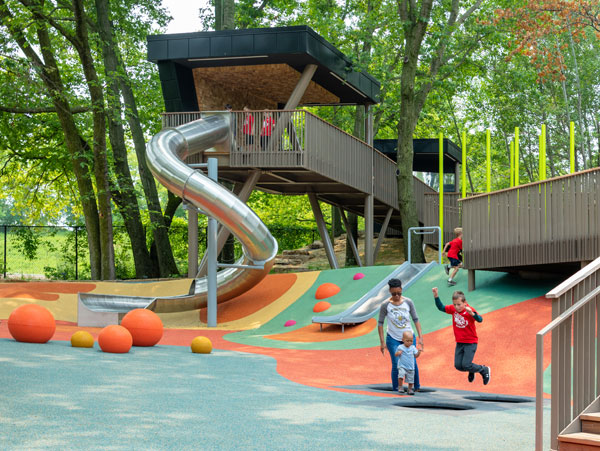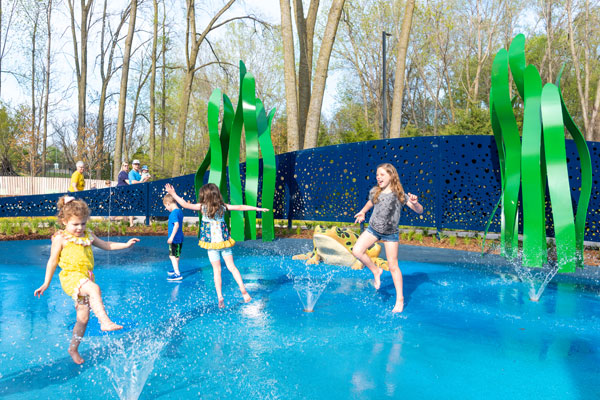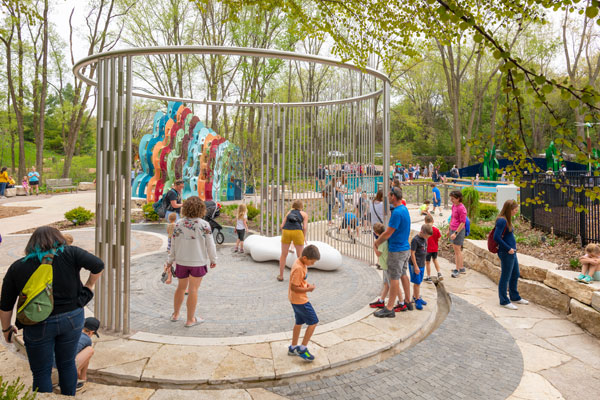As adults, it can be easy to start catastrophizing when the term “risky play” is brought up. In fact, Child Indicators Research has noted that in recent years, Western societies have shown signs of increasing risk aversion.
But why focus on the negative outcomes of risk when there are so many potential rewards? Risky play is about taking a low probability of injury in stride in favor of exciting experiences and childhood development. Initial fear will give way to the thrill of gained confidence as a child conquers new challenges on their own terms.
There’s a strong docket of literature that underscores the importance of risky play, much of which comes from the landmark study by researchers Sando, Kleppe, and Sandseter. They found that risky play improves children’s mental and physical wellbeing. The excitement and intrigue of risky play helps kids to be more physically active, challenging the possibility of injury by bringing significant physical health benefits to the table.
Sando et al. also found a positive association between risky play, spontaneity, and self-confidence. This is in part because risky play allows children to practice autonomy, letting them take full credit for guiding themselves through new accomplishments and explorations.

If that wasn’t enough already, risky play allows for early development of risk management skills. Professor Heather Von Bank points out that as adults, our day-today life is a series of calculated risks. From taking out loans to eating clearance sushi, we’re constantly making decisions based on our assessment of risks. Risky play allows children to form lifelong risk assessment skills that will eventually apply to more than just monkey bars, cartwheels, or even whether to try a new hobby.
Here at the Garden, we understand the value of risky play in childhood development. In fact, it influenced the design of the new Carol & Bruce Bell Children’s Garden. But, how do you create a controlled environment for children to engage in risky play? Risky play will look different for every kid, but Sandseter has identified six common traits:
Great Heights
Climbing, jumping, and exploring areas far above the ground is exhilarating. It can be a little scary, but once you find your footing in the canopy of the Green Bay Packaging George Kress Foundation Tree Houses, the birds’ eye view is unbeatable. Plus, finding your way back to the ground is much easier than shimmying down a tree. In fact, why not take the slide?


High Speed
Moving at high speeds, like zooming down a swirly slide or launching off of trampolines in the K.C. Stock Foundation Mushroom Jumper Play, is a great way to become more comfortable letting go of control and adapting to unpredictability. The thrill of the ride and the satisfaction of a safe landing bring kids back again and again!
Dangerous Tools
In the Bell Children’s Garden, we leave the dangerous tools to our Horticulture Team. After all, you’re here to explore nature, not prune trees or dig holes. At home, some activities with dangerous tools might be learning how to chop vegetables in the kitchen or using scissors to create crafts. Everyday objects like scissors and kitchen knives can cause injury, but are also essential to daily life. Having little wins with them from a young age is important for building confidence and learning safe techniques.


Dangerous Elements
The Garden doesn’t feature a giant gorge or river rapids. Still, challenging environmental elements like slippery pavement by the Gail R. Fischer Family Lily Pad Splash Play, steep hills, and stepping stones abound. Navigating a variety of outdoor environments can help children develop motor skills and become more self-assured.
Rough-and-Tumble Play
Whether a child visits the Bell Children’s Garden with friends or meets some while they’re here, playing together and rough housing is an important part of social development. Von Bank highlights that rough-and-tumble play allows kids to become more effective communicators, creating and respecting personal boundaries in the absence of rigid rules.


Independent Exploration
While it’s important to keep tabs on your child, it’s also critical that they get the chance to be led by their curiosity. Allowing them to take charge and explore the Schanock Family Hillside Tunnel and Cave Play area or discover the features of the Judy & Mike Parrish Family Rain Drop Garden builds confidence and problem solving skills for more future adventures on their own.
All things considered, one of the most important elements of risky play is you, the adult. Much of the time, the idea of risky play is a lot scarier for grown-ups than it is for kids. Rice highlights that bringing and expressing adult anxiety can cause guardians’ fears to impact their children. Instead, she suggests giving abundant positive feedback and expressing specific observations of potential danger when appropriate. Avoiding fearful exclamations and blanket statements allow for more thorough conversations that create better understanding and less anxiety.
The Bell Children’s Garden is 2.5 acres of outdoor adventure jam packed with fun for the whole family. Whether you’re new to risky play or are a frequent flyer, it’s a great place to explore small thrills in a safe and controlled environment. Plus, with educational signs, nature-inspired structures, and tons of other outdoor activities, you might even learn a thing or two!
Sources
- https://link.springer.com/chapter/10.1007/978-3-031-25552-6_2
- Kvalnes, Ø., Hansen Sandseter, E.B. (2023). Risky Play, Then and Now. In: Risky Play. Critical Cultural Studies of Childhood. Palgrave Macmillan, Cham. https://doi.org/10.1007/978-3-031-25552-6_2
- https://www.bbc.co.uk/tiny-happy-people/risky-play/znpwkty
- Rice, G. (2022, October 6). What are the benefits of risky play?. BBC Tiny Happy People. https://www.bbc.co.uk/tiny-happy-people/risky-play/znpwkty
- https://link.springer.com/article/10.1007/s12187-021-09804-5
- Sando, O.J., Kleppe, R. & Sandseter, E.B.H. Risky Play and Children’s Well-Being, Involvement and Physical Activity. Child Ind Res 14, 1435–1451 (2021). https://doi.org/10.1007/s12187-021-09804-5
- https://www.ted.com/talks/heather_von_bank_why_kids_need_to_take_risks
- Von Bank, H. (2022, March). Why Kids Need to Take Risks. TED. https://www.ted.com/talks/heather_von_bank_why_kids_need_to_take_risks












